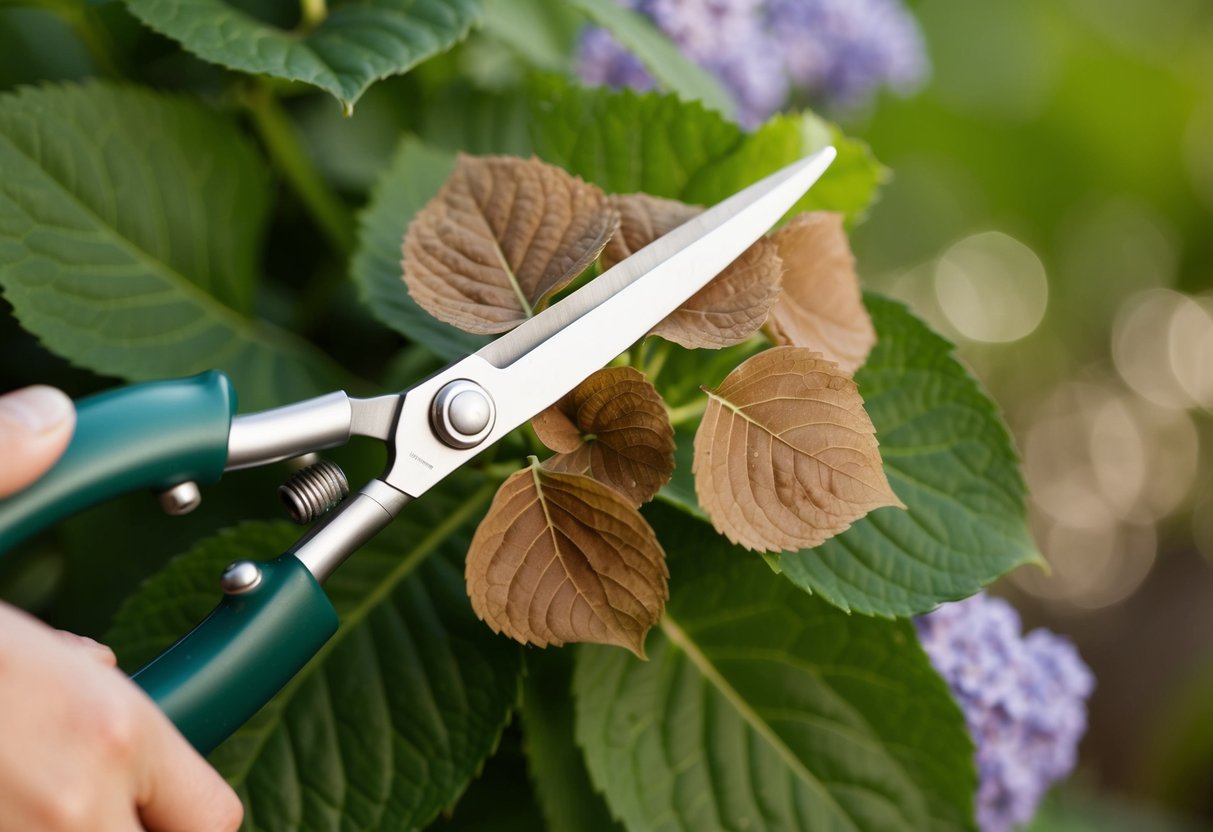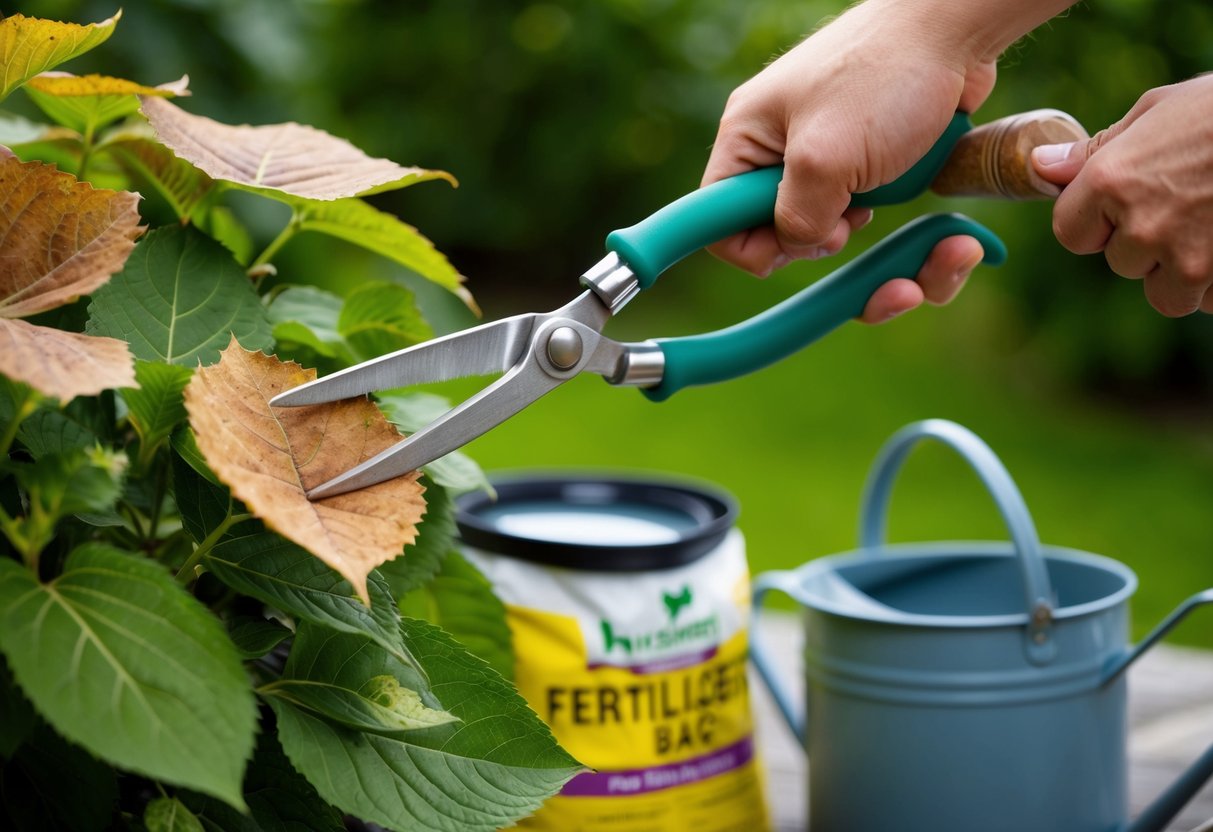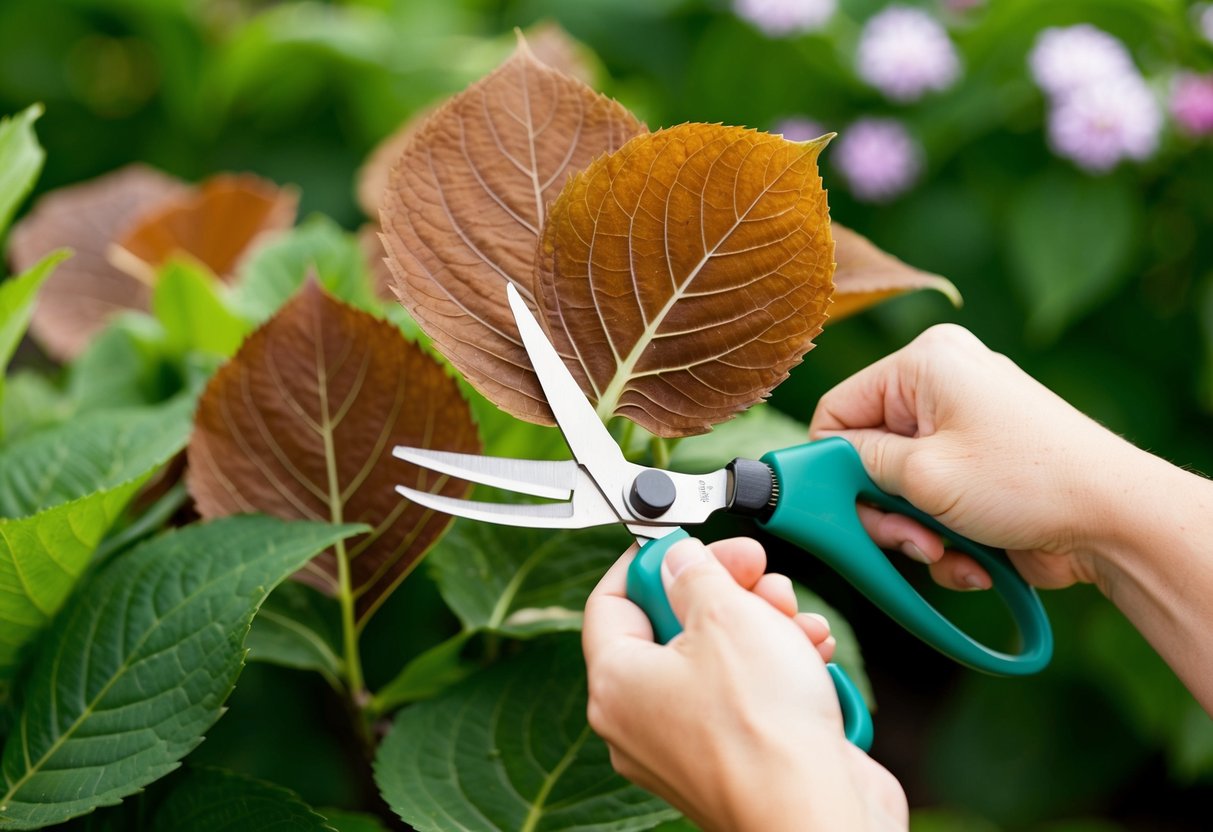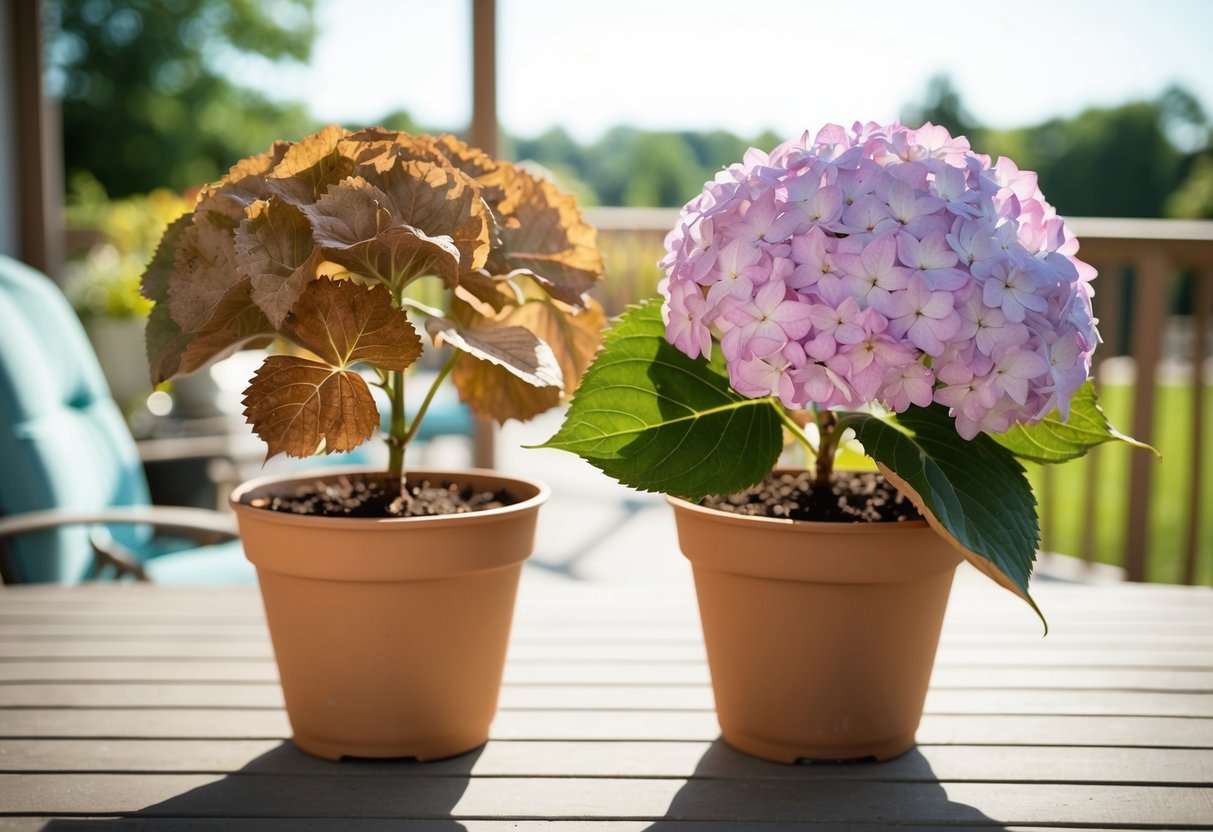Should I Cut Off Brown Hydrangea Leaves? Tips for Healthy Blooms
When you spot brown leaves on your hydrangeas, it might be tempting to snip them off immediately. The short answer is yes, you should cut off brown hydrangea leaves, but only if they appear damaged or diseased. This helps keep your plant healthy and looking its best. Think of it as giving your plant a fresh start by removing anything that might hinder its growth.

Brown hydrangea leaves can appear due to factors like too much sun exposure, insufficient watering, or late frosts affecting young leaves. These plants are quite resilient and can often recover if you address the root of the problem. Keeping an eye on your plant’s environment will help prevent future issues and keep those leaves green and vibrant.
Hydrangeas are known for their colorful blooms and lush green foliage, making them a favorite in many gardens. By managing brown leaves, you ensure that your hydrangeas not only remain healthy but continue to add beauty to your outdoor space.
Understanding Hydrangea Health

Keeping your hydrangeas healthy involves managing moisture levels, providing the right sunlight, and being aware of potential diseases and pests. By understanding these factors, you can ensure your plants thrive and display beautiful blooms.
The Role of Moisture
Hydrangeas need consistent moisture to stay healthy. Water them regularly, especially during dry spells. However, avoid overwatering, as this can lead to root rot and fungal diseases. The soil should be well-draining but retain some moisture. Consider mulching to help regulate soil moisture.
Monitor the soil by checking the top few inches to see if it feels dry. If it does, it’s a good time to water again. Keeping moisture levels balanced is key to preventing problems with plant health, such as browning leaves.
Sunlight and Shade Requirements
Hydrangeas thrive in a spot with morning sun and afternoon shade. While they need sunlight to grow, too much full sun exposure can lead to leaf scorching, which causes browning. Brown leaves reduce the plant’s ability to photosynthesize efficiently. If your hydrangeas are in full sun, consider providing them some shade during the hottest part of the day.
If moving the plant is not an option, you can create shade by using garden fabric or planting taller companions nearby. Ensuring enough shade in the afternoon helps protect your hydrangea leaves from the harsh sun while still allowing blooms to flourish.
Common Diseases and Pests
Hydrangeas are prone to diseases like powdery mildew and root rot, often caused by excess moisture and poor air circulation. Fungal spores can spread quickly in wet conditions, so keep plants well-spaced and prune them to improve airflow.
Pests such as aphids can also harm hydrangeas. Regularly inspect the leaves and stems and use insecticidal soap if necessary. Keeping your plants clean and healthy helps minimize the risk of these common issues. Watch for any signs of infection or infestation, and treat them promptly to maintain vibrant and vigorous growth.
The Importance of Proper Pruning

Pruning is essential for hydrangeas to maintain their shape and encourage healthy growth. By understanding when to prune and how to handle brown leaves, your plants will thrive and produce beautiful blooms.
When and How to Prune
Pruning at the right time is key for your hydrangeas to bloom properly. Identify the type of hydrangea you have, as different types require different pruning times. For instance, bigleaf hydrangeas form buds on old wood, so you should prune them right after flowering. Meanwhile, smooth and panicle hydrangeas bloom on new wood and can be pruned in late winter or early spring.
Using sharp, clean tools is important to make precise cuts just above healthy buds. Pruning encourages new growth and helps shape flowering shrubs. Over-pruning can harm your plant, so it’s wise to aim for balance—remove dead or weak stems without taking off too much healthy wood. This careful approach ensures your hydrangeas will have a full season of lovely blooms.
Deadheading and Removing Brown Leaves
Deadheading, or removing spent flowers, keeps your hydrangeas neat and encourages fresh blooms. Snip old flowers just above the first pair of leaves. Regular deadheading throughout the blooming period can lead to a more continuous display of flowers.
Brown leaves should be trimmed back to maintain plant health. These leaves might be damaged or diseased, so removing them can prevent problems from spreading. Cut back the affected leaf to the stem, making clean, precise cuts. Doing this not only improves the plant’s appearance but also helps your hydrangea focus its energy on healthy growth. Keeping up with these tasks ensures your flowering shrubs stay vibrant all season.
Watering and Fertilizing Techniques

To keep your hydrangeas healthy, it’s important to give them the right amount of water and nutrients. Learn how to create a balanced watering schedule and choose the appropriate fertilizer to promote beautiful blooms.
Creating an Effective Watering Schedule
Hydrangeas love water but can suffer if overwatered. Regular watering is key, especially during hot, dry spells. Check the soil moisture by sticking your finger into the ground; if it’s dry, it’s time to water. Early morning or late afternoon is the best time to water, reducing evaporation.
Consider adding mulch around the base of your hydrangeas to help retain moisture. This can be bark, leaves, or even compost. Be cautious of overwatering, which can lead to root rot. Keep your watering schedule consistent but flexible, responding to your plant’s needs and the weather.
Choosing the Right Fertilizer
Using the correct fertilizer can make a big difference. Hydrangeas benefit from slow-release fertilizers that work over time. Look for a balanced mix with nitrogen, phosphorous, and potassium. Too much nitrogen can cause lush leaves but fewer blooms, leading to over-fertilization problems.
Apply fertilizer in spring, using the recommended amount listed on the package to avoid fertilizer burn. If preferred, you can add compost to improve soil quality naturally. Keeping a careful balance of nutrients ensures your hydrangea grows strong and produces vibrant flowers.
Optimizing Soil and Environmental Conditions

Creating the best environment for your hydrangeas means paying attention to soil conditions and protecting them from weather stress. This helps the plants stay healthy and reduces the chance of seeing those pesky brown leaves.
Soil Conditions and Drainage
Hydrangeas love moist soil, but it’s crucial that the soil doesn’t stay too wet. Make sure your soil has good drainage to prevent water from sitting at the roots, which can lead to root rot. Use organic matter like compost to improve the soil texture, ensuring it retains just the right amount of moisture.
Check the pH levels of your soil, too. Hydrangeas usually prefer slightly acidic to neutral pH. You can test soil pH with a simple kit available at gardening stores. Adjusting the pH can sometimes help the hydrangeas take in nutrients more effectively.
Limit overhead watering. Instead, water around the base of the plant to keep leaves dry and reduce fungal problems. This pays off by keeping your hydrangeas looking fresh and lively.
Dealing with Weather and Environmental Stress
Weather can be a big factor in how your hydrangeas look. Drought stress is common, especially during hot, dry spells. Make sure to water your hydrangeas deeply whenever the top inch of soil feels dry to the touch.
Weather damage like strong winds can dry out leaves, leading to browning. Placing your hydrangeas in a location shielded from harsh winds can help protect them. If your area often has severe weather, consider putting up a simple windbreak or using a temporary cover during particularly harsh conditions to provide extra protection.
Special Considerations for Potted Hydrangeas

Caring for potted hydrangeas requires a little extra attention. These flowering plants need the right balance of light and water.
Place your potted hydrangeas in an area with partial shade or partial sun to protect them from too much sunlight. Too much direct sun can cause leaf burn.
Hydrangeas in pots can dry out quickly. Ensure you water them regularly to prevent under-watering, but be careful not to over-water. The soil should be consistently moist.
Transplant shock can occur if you move your hydrangea into a new pot or location. To minimize this, keep them in a spot with stable conditions and avoid drastic changes in temperature or light.
If the leaves start to brown, it could be from stress. Check that your hydrangea is not in direct sunlight for too long and adjust your watering schedule as needed.







